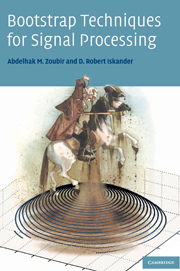4 - Bootstrap model selection
Published online by Cambridge University Press: 03 December 2009
Summary
Many engineering applications require parametric modelling. On one hand, there exist statistical models based on real observations of our physical environment (Hahn and Shapiro, 1967); an example of this is statistical modelling of interference (Jakeman and Pusey, 1976; Middleton, 1999). On the other hand, there exist generic models to describe data, such as autoregressive models, commonly used in both signal processing and time series analysis (see Section 2.1.4). In previous chapters, we focused our attention on estimation problems. Given measurements, it is also of importance to decide which model best fits the data. More often we are required to select a model and perform a conditional estimation of the parameters of interest. When we say select a model we mean choose a particular set of parameters in the given model. The conditional estimation refers then to the estimation of those parameters conditioned on the chosen model.
Bootstrap methods based on residuals can be used to select the best model according to a certain prediction criterion. In this chapter, we consider application of bootstrap model selection methods to both linear and nonlinear models. The methods presented are consistent and in most cases they out-perform classical techniques of model selection. We also report on how the methods apply to dependent data models such as autoregressive models.
- Type
- Chapter
- Information
- Bootstrap Techniques for Signal Processing , pp. 103 - 129Publisher: Cambridge University PressPrint publication year: 2004



